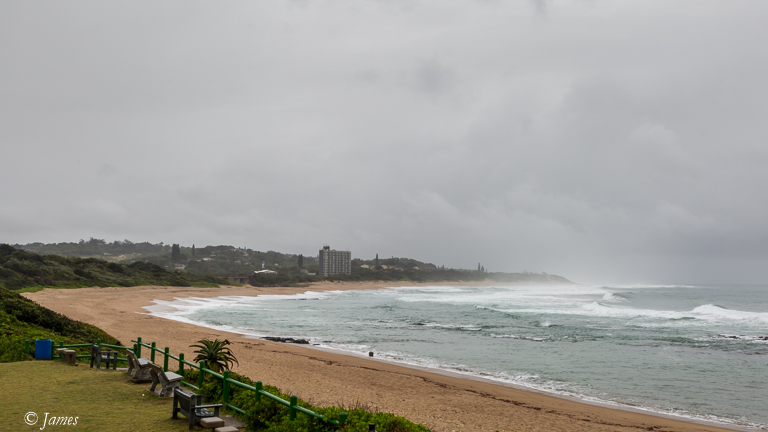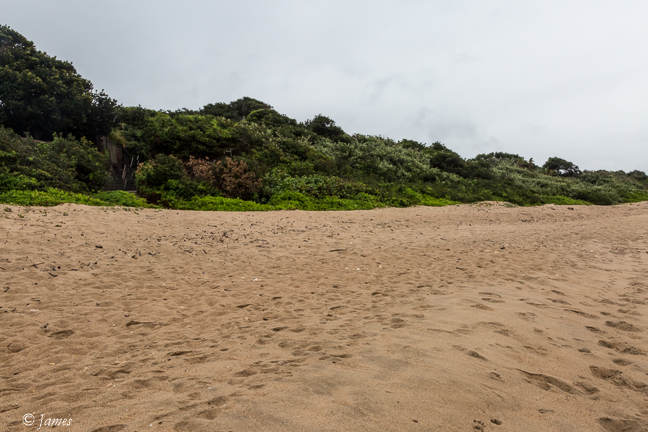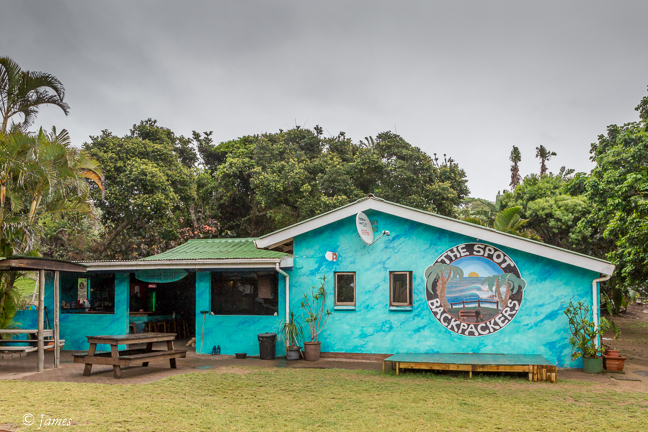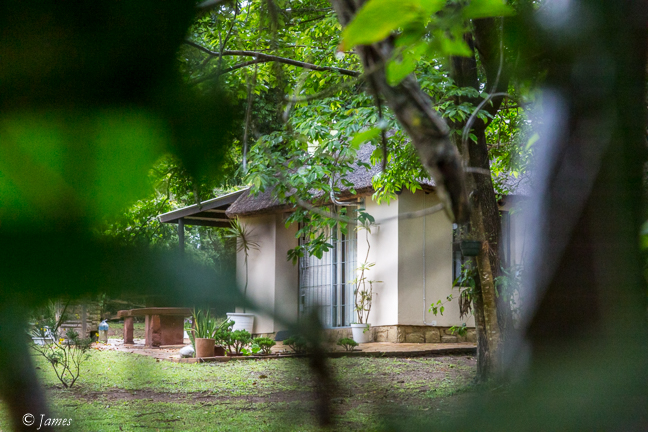The weather had changed, clouds hung over the mountains, and then the rain started. I left at 7.50am, arriving in Margate about 3pm, having stopped for some time, first at Amanzimtoti, Winkelspruit, then Umtentwini.
Winkelspruit is significant as the place I went to with my parents as a 6-7 year old, where we stayed in a large timber frame house on the hillside overlooking the river and sea. It may have been a lodging house, and I think the owners were friends. For a long time I thought the ‘winkel’ was referring to a sea urchin, only later realised that it means ‘store river’. Now its all flats.
Amanzimtoti is the next beach to the east. It is the place of our last holiday (June/July 1980) before leaving for Australia. On approaching the beach one morning, we joined in the flurry of action as the ‘sardine run’ had started. The sardine run is an annual migration of pilchard, Sardinops sagax, attracting people, birds, as well sharks, Humpback whales, and dolphin superpods. The kids loved it.
We had lost faith in that the country could survive as a western nation, and considered Australia. On our last day I bought a newspaper to start the fire for a braai (BBQ), read it first, and found an advert for a geologist on a tin mine in the Queensland Atherton Tablelands, a beautiful area, and decided to apply. That started the process for emigration. We attended the Australian Embassy in Pretoria in November, and by January had permanent residence status – unheard of today. I wrote to a contact in Brisbane, Tim Spencer, asking for addresses of mining businesses; he posted a long list. I found later that some were managed by the same office so they received several letters from me. At Easter I flew to Perth, stayed for two nights in the Grand Hotel opposite the Rail Station (now a backpackers) arriving at 4am. I was a wreck that day knocking on many doors, including Western Mining where I met with a geologist I had worked with at St Helena Gold Mine. He drove me around Perth, up to Kings Park, in a car with huge kangaroo bars, very common at the time. He had arranged a flight to Kalgoorlie for me, where I was met and driven to Kambalda. That was a very good team in those days, and I would have been better off there financially, than Tasmania, but I was keen to go where the rain fell, and there were forests, mountains, and rivers. I flew back on the small postal plane. That Thursday evening I was surprised to find the Hay Street mall busy; I remember speaking to an evangelist. I had booked to fly to Melbourne on Friday at 3pm, and only had time to visit Greenbushes Tin office – they were upset I had left so little time for them.
I expected to still have time in Melbourne to visit Electrolytic Zinc, but had not realised the distance and time change, arriving that evening. I rented a car and drove into the Dandenongs east of the city, spent time in the city, and the Botanic Garden, loving it all. Monday I went to EZ. Most of the interview was me asking for information, rather than the other way. At one interview I was told my gold experience would be best suited to the Victorian gold mines – I was unimpressed thinking of very old mines rather than the State of Victoria! I flew on to Sydney, visited a few businesses there, staying in a flat with a woman I had met somewhere I cannot remember. That weekend we drove south to the Royal National Park, and then north to Ku-ring-gai. These parks are, of course, beautiful, but the mines are inland. Next on to Tim in Brisbane, spoke to Mt Isa Mining, another great business, and finally to Townsville to another geologist I worked with in S Africa. EZ called to say they had arranged a flight to Wynyard in Tasmania, and a rental car to check Rosebery out. Looking on the map, I thought it would take an hour to drive, but owing to the twists and turns plus the Hellyer Gorge, that took 2 hours. I found people playing footie in a drizzle, walking in the street, as though rain didn’t touch them! I met the team at Rosebery Mine, returned home and 6 weeks later we were in Melbourne, Wednesday 6 June 1981. Umtentwini beach was ‘our’ beach for many holidays. We would set the umbrellas up near the sandy path to the beach through the high trees and sand dune vegetation from the small car park past the cafe. The kids loved to swim there between the flags, or else in the sea pool further to the south. Today, the cafe is a backpackers. We stayed in a thatched round room (rondavel) that had a small square section at the back for the bathroom and kitchen. The main room was divided in two by a high wall; a double bed one side, bunks on the other. The Eden Park rooms are now privately owned as homes. We loved the area so bought a block on Lugg Ave, only reselling after leaving SA, enabling us to buy a block in Tasmania. The town has retained most of the natural vegetation, including the big trees, though sadly not on ‘our’ block.

Tugela Falls B&B 
Winkelspruit 
Amanzimtoti 
Cafe path 
Kids pool 
Beach south 
Beach north 
Our spot – north 
Our path 
Cafe path 
Cafe site 
Our Beach 
Cafe? 
Our Block? 12 Lugg 
Our Block? 14 Lugg 
Eden Park 
Eden Park 
Eden Park 
Eden Park
